Distribution Pattern of Landslides Triggered by the 2014 Ludian Earthquake of China: Implications for Regional Threshold Topography and the Seismogenic Fault Identification
Abstract
:1. Introduction
2. Regional Tectonic Background and Seismicity
3. Study Area
4. Material and Methods
4.1. Data
4.2. Visual Interpretation of Landslides
4.3. Analysis of Co-Seismic Landslide Controlling Factors’ Influence
5. Results and Discussions
5.1. Landslide Inventory
5.2. Analysis of the Landslide Inventory
5.2.1. Landslide Size
5.2.2. Area Affected by Earthquake-Induced Landslides
5.3. Co-Seismic Landslides Controlling Factors Analysis
5.3.1. Lithology
5.3.2. Topographic Parameters
5.3.3. Earthquake-Related Factors
6. Implications from Co-Seismic Landslide Distribution
6.1. Implication for the Threshold Topography
6.2. Implication for the Seismogenic Fault Identification
7. Conclusions
Acknowledgments
Author Contributions
Conflicts of Interest
Abbreviations
| CEA | China Earthquake Administration |
| CEDC | Chinese Earthquake Data Centre |
| GIS | Geographic Information System |
| LAR | Landslide area ratio |
| LD | Landslide density |
| LN | Landslide number |
| NGAC | National Geology Archive of China |
| USGS | United States Geology Survey |
References
- China Earthquake Network Center. Available online: http://www.cmec.ac.cn (accessed 20 January 2016).
- China Earthquake Administration. Available online: http://www.cea.gov.cn/ (accessed 20 January 2016).
- Li, Z.S. The state of the art of the research on seismic landslide hazard at home and abroad. J. Catastrophol. 2003, 18, 64–70. [Google Scholar]
- Keefer, D.K. Landslides caused by earthquakes. Geol. Soc. Am. Bull. 1984, 95, 406–421. [Google Scholar]
- Wang, H.B.; Sassa, K.; Xu, W.Y. Analysis of a spatial distribution of landslides triggered by the 2004 Chuetsu earthquakes of Niigata Prefecture, Japan. Nat. Hazards 2007, 41, 43–60. [Google Scholar] [CrossRef]
- Sassa, K. Landslide disasters triggered by the 2004 Mid-Niigata Prefecture earthquake in Japan. Landslides 2005, 2, 135–142. [Google Scholar] [CrossRef]
- Sato, H.P.; Hasegawa, H.; Fujiwara, S.; Tobita, M.; Koarai, M.; Une, H.; Iwahashi, J. Interpretation of landslide distribution triggered by the 2005 Northern Pakistan earthquake using SPOT 5 imagery. Landslides 2006, 4, 113–122. [Google Scholar] [CrossRef]
- Owen, L.A.; Kamp, U.; Khattak, G.A.; Harp, E.L.; Keefer, D.K.; Bauer, M.A. Landslides triggered by the 8 October 2005 Kashmir earthquake. Geomorphology 2008, 94, 1–9. [Google Scholar] [CrossRef]
- Yin, Y.; Wang, F.; Sun, P. Landslide hazards triggered by the 2008 Wenchuan earthquake, Sichuan, China. Landslides 2009, 6, 139–152. [Google Scholar] [CrossRef]
- Gorum, T.; Fan, X.; van Westen, C.J.; Huang, R.Q.; Xu, Q.; Tang, C.; Wang, G. Distribution pattern of earthquake-induced landslides triggered by the 12 May 2008 Wenchuan earthquake. Geomorphology 2011, 133, 152–167. [Google Scholar] [CrossRef]
- Miyagi, T.; Higaki, D.; Yagi, H.; Doshida, S.; Chiba, N.; Umemura, J.; Satoh, G. Reconnaissance report on landslide disasters in northeast Japan following the M 9 Tōhoku earthquake. Landslides 2011, 8, 339–342. [Google Scholar] [CrossRef]
- Wartman, J.; Dunham, L.; Tiwari, B.; Pradel, D. Landslides in eastern Honshu induced by the 2011 Tohoku Earthquake. Bull. Seismol. Soc. Am. 2013, 103, 1503–1521. [Google Scholar] [CrossRef]
- Zhou, S.; Fang, L. Support vector machine modeling of earthquake-induced landslides susceptibility in central part of Sichuan province, China. Geoenviron. Disasters 2015, 2, 2. [Google Scholar] [CrossRef]
- Zhou, S.; Fang, L.; Liu, B. Slope unit-based distribution analysis of landslides triggered by the April 20, 2013, Ms 7.0 Lushan earthquake. Arab. J. Geosci. 2015, 8, 7855–7868. [Google Scholar] [CrossRef]
- Yin, Z.; Zhao, W.; Qin, X. Distribution characteristics of geohazards induced by the Lushan Earthquake and their comparisons with the Wenchuan Earthquake. J. Earth Sci. 2014, 25, 912–923. [Google Scholar] [CrossRef]
- Qiao, G.; Lu, P.; Scaioni, M.; Xu, S.; Tong, X.; Feng, T.; Wu, H.; Chen, W.; Tian, Y.; Wang, W.; Li, R. Landslide investigation with remote sensing and sensor network: from susceptibility mapping and scaled-down simulation towards in situ sensor network design. Remote Sens. 2013, 5, 4319–4346. [Google Scholar] [CrossRef]
- Scaioni, M.; Longoni, L.; Melillo, V.; Papini, M. Remote sensing for landslide investigations: An overview of recent achievements and perspectives. Remote Sens. 2014, 6, 9600–9652. [Google Scholar] [CrossRef]
- Guzzetti, F.; Mondini, A.C.; Cardinali, M.; Fiorucci, F.; Santangelo, M.; Chang, K.T. Landslide inventory maps: New tools for an old problem. Earth-Science Rev. 2012, 112, 42–66. [Google Scholar] [CrossRef]
- Rodríguez, C.E.; Bommer, J.J.; Chandler, R.J. Earthquake-induced landslides: 1980–1997. Soil Dyn. Earthq. Eng. 1999, 18, 325–346. [Google Scholar] [CrossRef]
- Prestininzi, A.; Romeo, R. Earthquake-induced ground failures in Italy. Eng. Geol. 2000, 58, 387–397. [Google Scholar] [CrossRef]
- Papadopoulos, G.A.; Plessa, A. Magnitude-distance relations for earthquake-induced landslides in Greece. Eng. Geol. 2000, 58, 377–386. [Google Scholar] [CrossRef]
- Bommer, J.J.; Rodríguez, C.E. Earthquake-induced landslides in Central America. Eng. Geol. 2002, 63, 189–200. [Google Scholar] [CrossRef]
- Chen, X.L.; Zhou, Q.; Ran, H.; Dong, R. Earthquake-triggered landslides in southwest China. Nat. Hazards Earth Syst. Sci. 2012, 12, 351–363. [Google Scholar] [CrossRef]
- Khazai, B.; Sitar, N. Evaluation of factors controlling earthquake-induced landslides caused by Chi-Chi earthquake and comparison with the Northridge and Loma Prieta events. Eng. Geol. 2004, 71, 79–95. [Google Scholar] [CrossRef]
- Collins, B.D.; Kayen, R.; Tanaka, Y. Spatial distribution of landslides triggered from the 2007 Niigata Chuetsu-Oki Japan Earthquake. Eng. Geol. 2012, 127, 14–26. [Google Scholar] [CrossRef]
- Xu, C.; Xu, X.; Shyu, J.B.H.; Gao, M.; Tan, X.; Ran, Y.; Zheng, W. Landslides triggered by the 20 April 2013 Lushan, China, Mw 6.6 earthquake from field investigations and preliminary analyses. Landslides 2015, 12, 365–385. [Google Scholar] [CrossRef]
- China Earthquake Data Centre. Available online: http://data.earthquake.cn/ (accessed 20 January 2016).
- Huang, R.Q.; Li, W.L. Analysis of the geo-hazards triggered by the 12 May 2008 Wenchuan Earthquake, China. Bull. Eng. Geol. Environ. 2009, 68, 363–371. [Google Scholar] [CrossRef]
- Yong, Z.; Xu, L.S.; Chen, Y.T.; Liu, R.F. Rupture process of the 3 august 2014 ludian, yunnan, Mw 6.1 (Ms6.5) Earthquake. Chinese J. Geophys. Ed. 2014, 9, 3052–3059. (In Chinese) [Google Scholar]
- Xu, X.; Jiang, G.; Yu, G.; Wu, X.; Jianguo, Z.; Li, X. Discussion on seismogenic fault of the Ludian MS6.5 earthquake and its tectonic attribution. CHINESE J. Geophys. Ed. 2014, 57, 3060–3068. [Google Scholar]
- United States Geology Survey. Available online: http://earthquake.usgu.gov/ (accessed 20 January 2016).
- ASTER Global Digital Elevation Model. Available online: http://gdem.ersdac.jspacesystems.or.jp (accessed 20 January 2016).
- National Geology Archive of China. Available online: http://www.ngac.cn/ (accessed 20 January 2016).
- Dai, F.C.; Xu, C.; Yao, X.; Xu, L.; Tu, X.B.; Gong, Q.M. Spatial distribution of landslides triggered by the 2008 Ms 8.0 Wenchuan earthquake, China. J. Asian Earth Sci. 2011, 40, 883–895. [Google Scholar] [CrossRef]
- Tang, B.; Liu, S.; Liu, S. Mountain disaster formation in northwest Sichuan. GeoJournal 1994, 34, 41–46. [Google Scholar] [CrossRef]
- Keefer, D.K. Investigating landslides caused by earthquakes—A historical review. Surv. Geophys. 2002, 23, 473–510. [Google Scholar] [CrossRef]
- Li, W.L.; Huang, R.Q.; Tang, C.; Xu, Q.; van Westen, C. Co-seismic landslide inventory and susceptibility mapping in the 2008 Wenchuan Earthquake disaster area, China. J. Mt. Sci. 2013, 10, 339–354. [Google Scholar] [CrossRef]
- Zhou, J.W.; Cui, P.; Fang, H. Dynamic process analysis for the formation of Yangjiagou landslide-dammed lake triggered by the Wenchuan earthquake, China. Landslides 2013, 10, 331–342. [Google Scholar] [CrossRef]
- Li, G.; West, A.J.; Densmore, A.L.; Jin, Z.; Parker, R.N.; Hilton, R.G. Seismic mountain building: Landslides associated with the 2008 Wenchuan earthquake in the context of a generalized model for earthquake volume balance. Geochemistry, Geophys. Geosystems 2014, 15, 833–844. [Google Scholar] [CrossRef] [Green Version]
- Chen, Q.; Cheng, H.; Yang, Y.; Liu, G.; Liu, L. Quantification of mass wasting volume associated with the giant landside Daguangbao induced by the 2008 Wenchuan earthquake from persistent scatterer InSAR. Remote Sens. Environ. 2014, 152, 125–135. [Google Scholar] [CrossRef]
- Hasegawa, S.; Dahal, R.K.; Nishimura, T.; Nonomura, A.; Yamanaka, M. DEM-Based analysis of earthquake-induced shallow landslide susceptibility. Geotech. Geol. Eng. 2009, 27, 419–430. [Google Scholar] [CrossRef]
- Qi, S.; Xu, Q.; Lan, H.; Zhang, B.; Liu, J. Spatial distribution analysis of landslides triggered by 2008.5.12 Wenchuan Earthquake, China. Eng. Geol. 2010, 116, 95–108. [Google Scholar] [CrossRef]
- Huang, Y.; Yu, M.; Xu, Q.; Sawada, K.; Moriguchi, S.; Yashima, A.; Liu, C.; Xue, L. InSAR-derived digital elevation models for terrain change analysis of earthquake-triggered flow-like landslides based on ALOS/PALSAR imagery. Environ. Earth Sci. 2014, 73, 7661–7668. [Google Scholar] [CrossRef]
- De Guidi, G.; Scudero, S. Landslide susceptibility assessment in the Peloritani Mts. (Sicily, Italy) and clues for tectonic control of relief processes. Nat. Hazards Earth Syst. Sci. 2013, 13, 949–963. [Google Scholar] [CrossRef]
- Ren, Z.; Zhang, Z.; Dai, F.; Yin, J.; Zhang, H. Co-seismic landslide topographic analysis based on multi-temporal DEM-A case study of the Wenchuan earthquake. Springerplus 2013, 2, 544. [Google Scholar] [CrossRef] [PubMed]
- Dietrich, W.E.; Montgomery, D.R. Scale Dependence and Scale Invariance in Hydrology; Sposito, G., Ed.; Cambridge University Press: New York, NY, USA, 1998. [Google Scholar]
- Tucker, G.E.; Bras, R.L. Hillslope processes, drainage density, and landscape morphology. Water Resour. Res. 1998, 34, 2751. [Google Scholar] [CrossRef]
- Egholm, D.L.; Knudsen, M.F.; Sandiford, M. Lifespan of mountain ranges scaled by feedbacks between landsliding and erosion by rivers. Nature 2013, 498, 475–478. [Google Scholar] [CrossRef] [PubMed]
- Larsen, I.J.; Montgomery, D.R. Landslide erosion coupled to tectonics and river incision. Nat. Geosci. 2012, 5, 468–473. [Google Scholar] [CrossRef]
- National Engineering Laboratory for High-speed Railway Construction. Available online: http://hsrlab.csu.edu.cn/index.aspx (accessed 20 January 2016).
- Burbank, D.W.; Leland, J.; Fielding, E.; Anderson, R.S.; Brozovic, N.; Reid, M.R.; Duncan, C. Bedrock incision, rock uplift and threshold hillslopes in the northwestern Himalayas. Nature 1996, 379, 505–510. [Google Scholar] [CrossRef]
- Xu, C.; Xu, X.; Yu, G. Landslides triggered by slipping-fault-generated earthquake on a plateau: an example of the 14 April 2010, Ms 7.1, Yushu, China earthquake. Landslides 2012, 10, 421–431. [Google Scholar] [CrossRef]
- Tibaldi, A.; Ferrari, L.; Pasquarè, G. Landslides triggered by earthquakes and their relations with faults and mountain slope geometry: an example from Ecuador. Geomorphology 1995, 11, 215–226. [Google Scholar] [CrossRef]
- Meunier, P.; Uchida, T.; Hovius, N. Landslide patterns reveal the sources of large earthquakes. Earth Planet. Sci. Lett. 2013, 363, 27–33. [Google Scholar] [CrossRef]
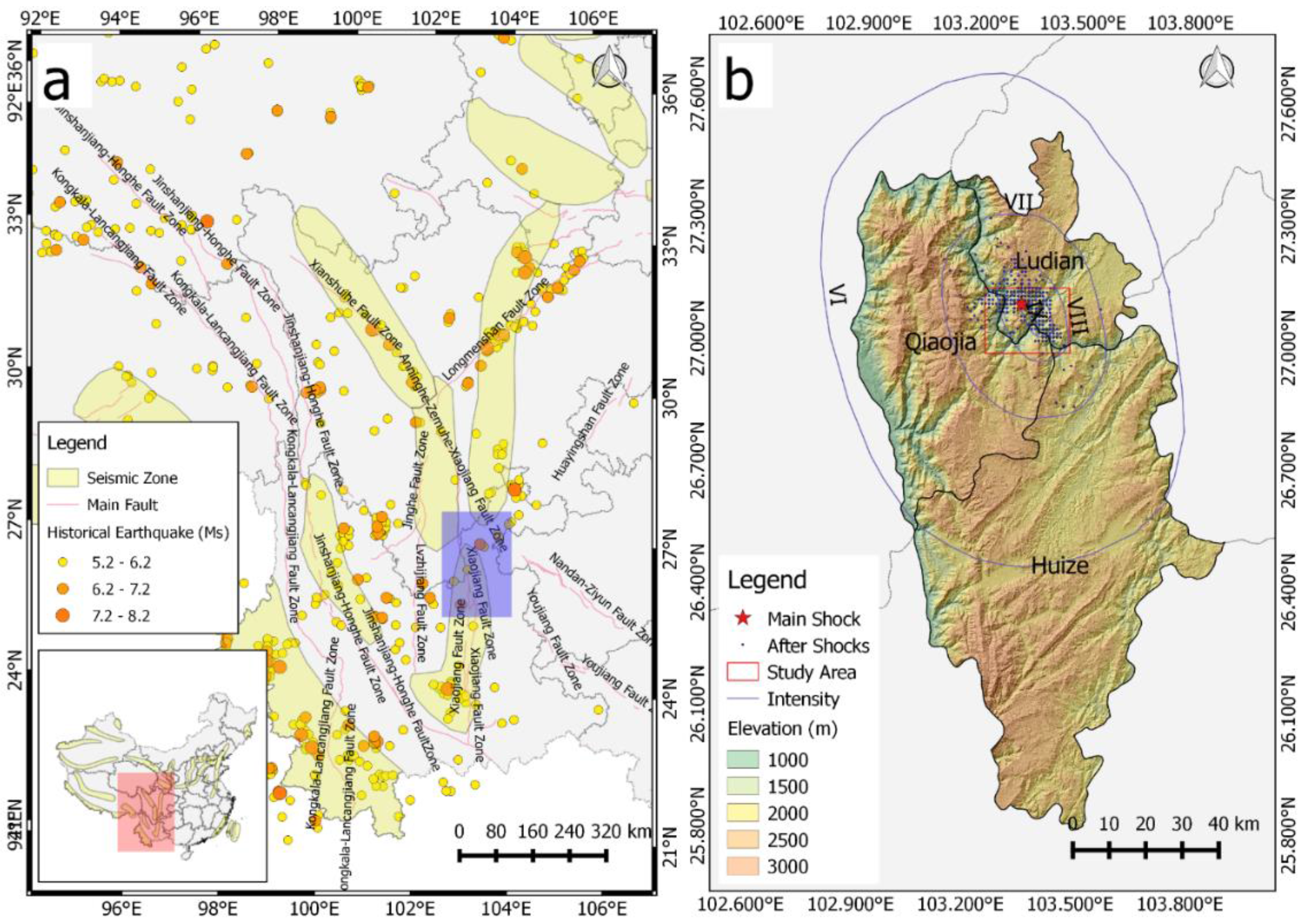
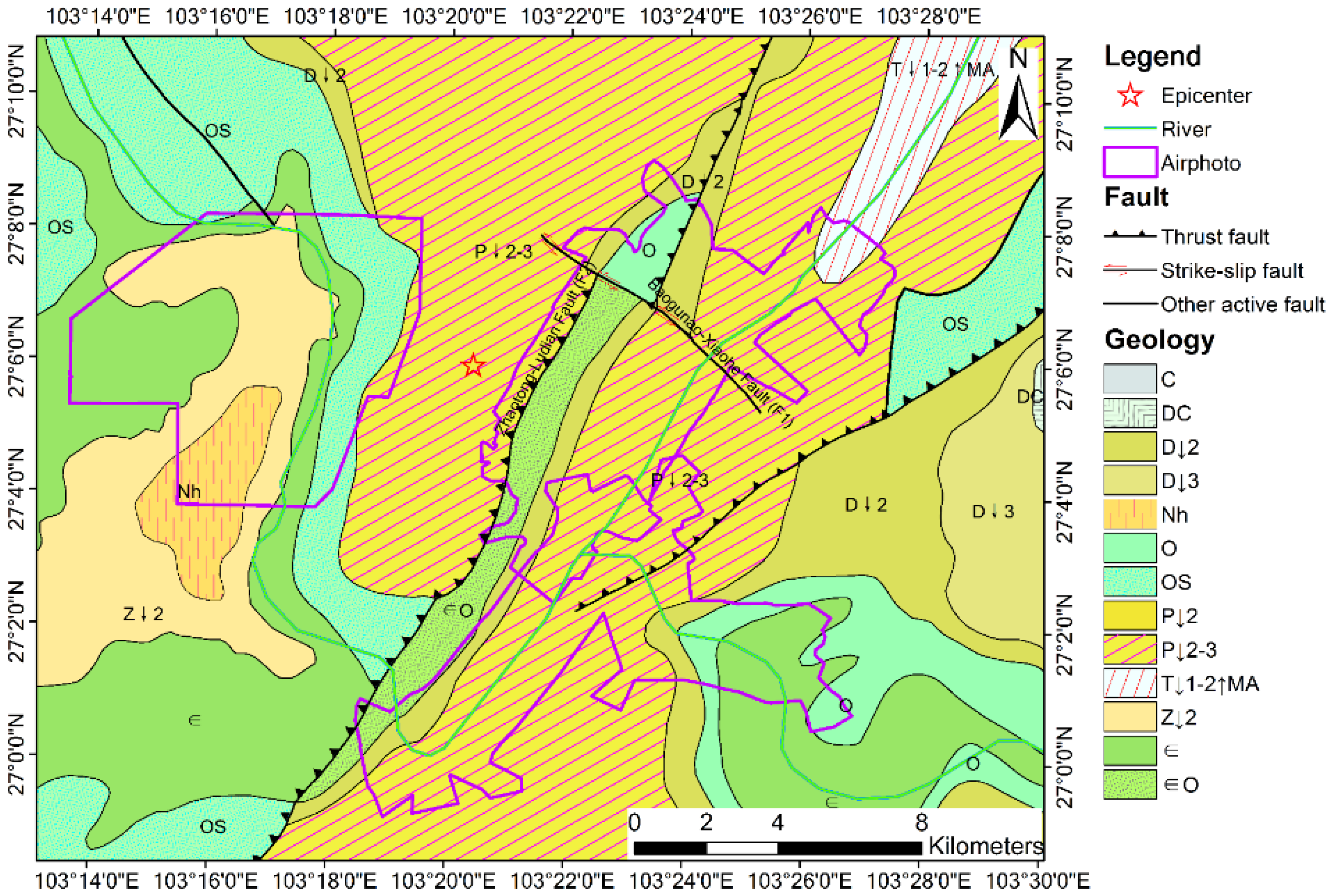
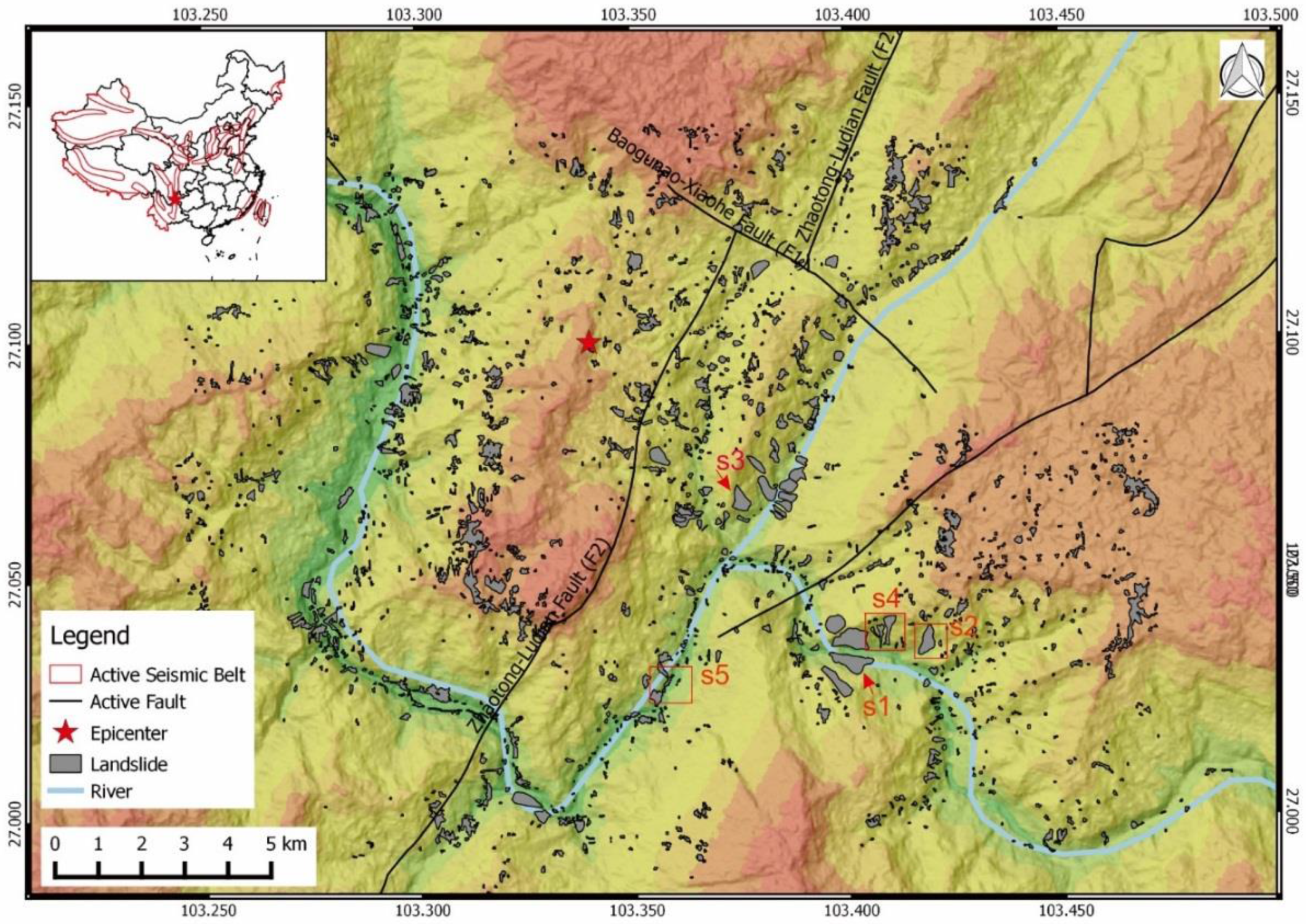
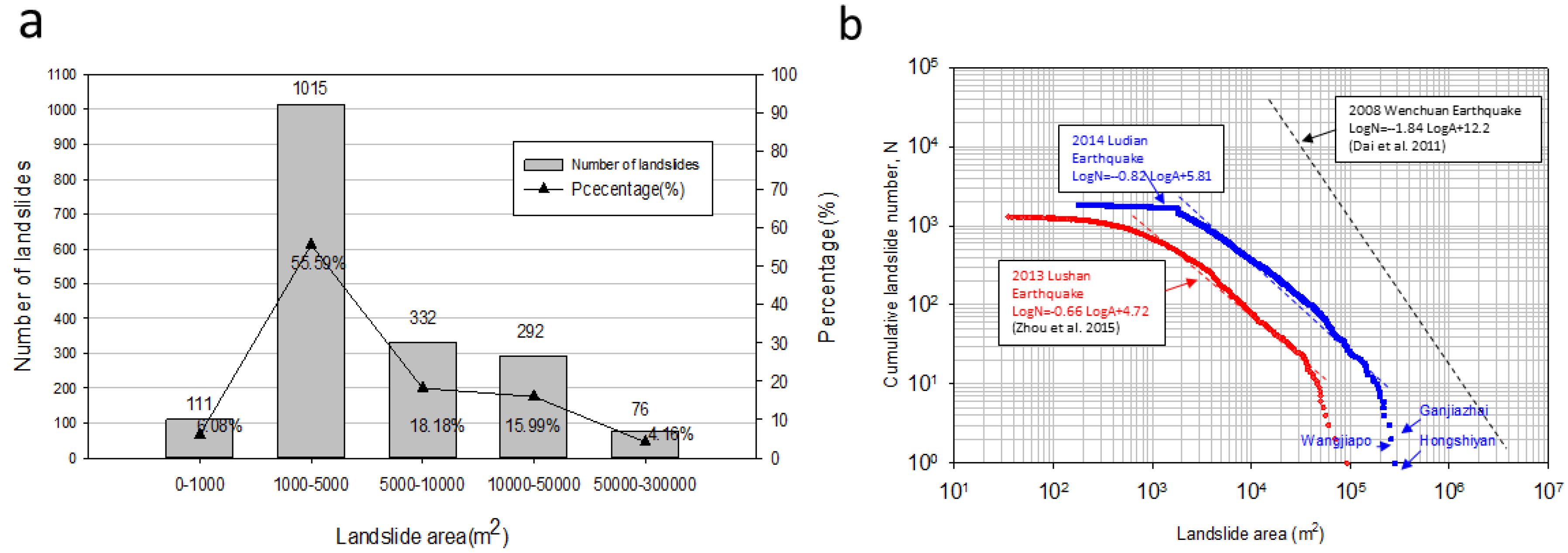
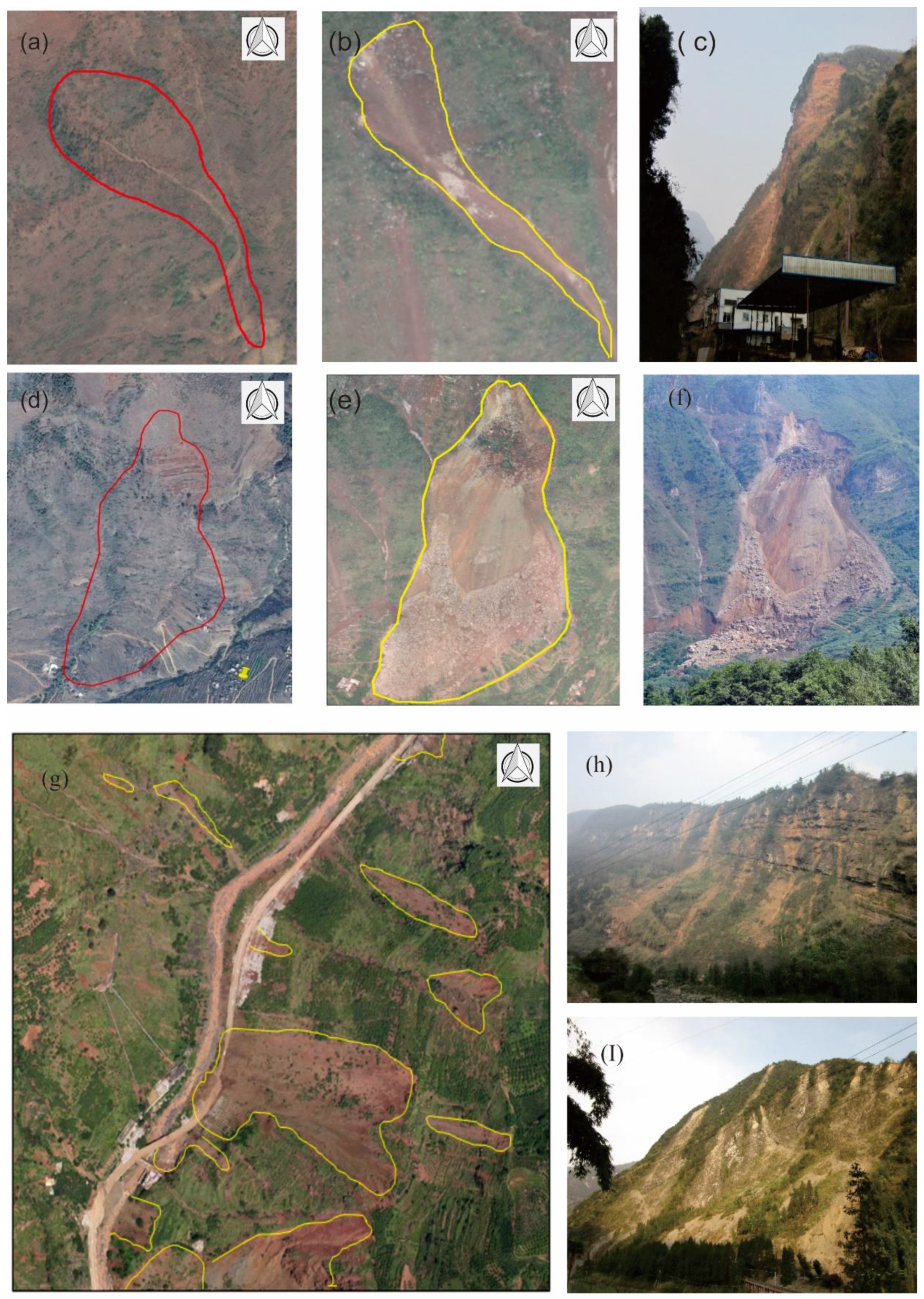
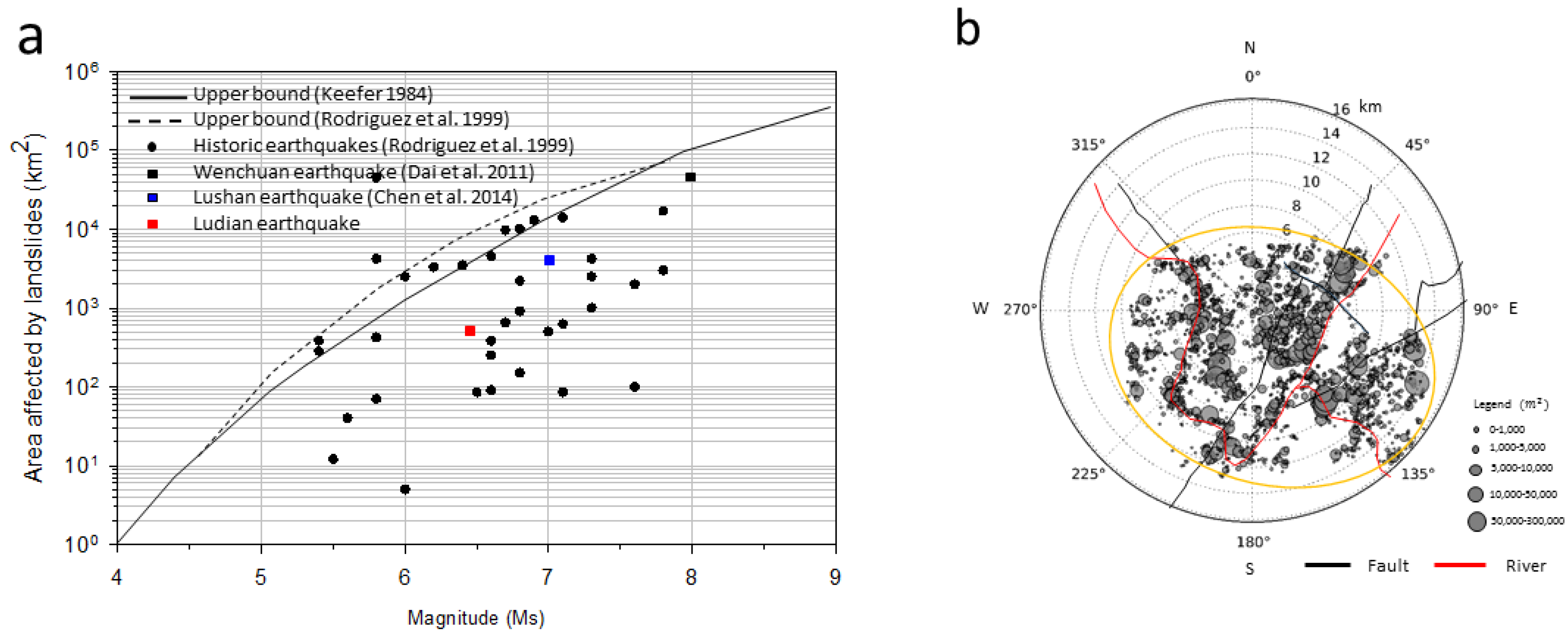

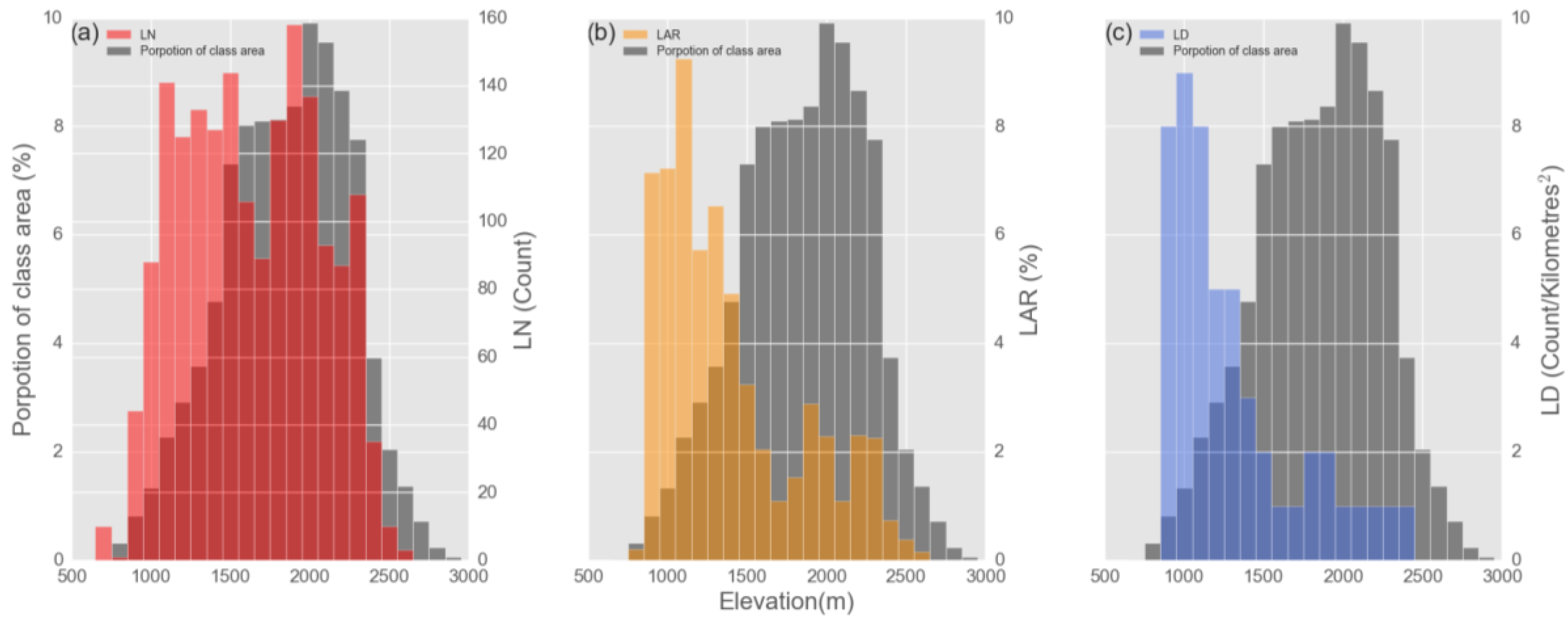
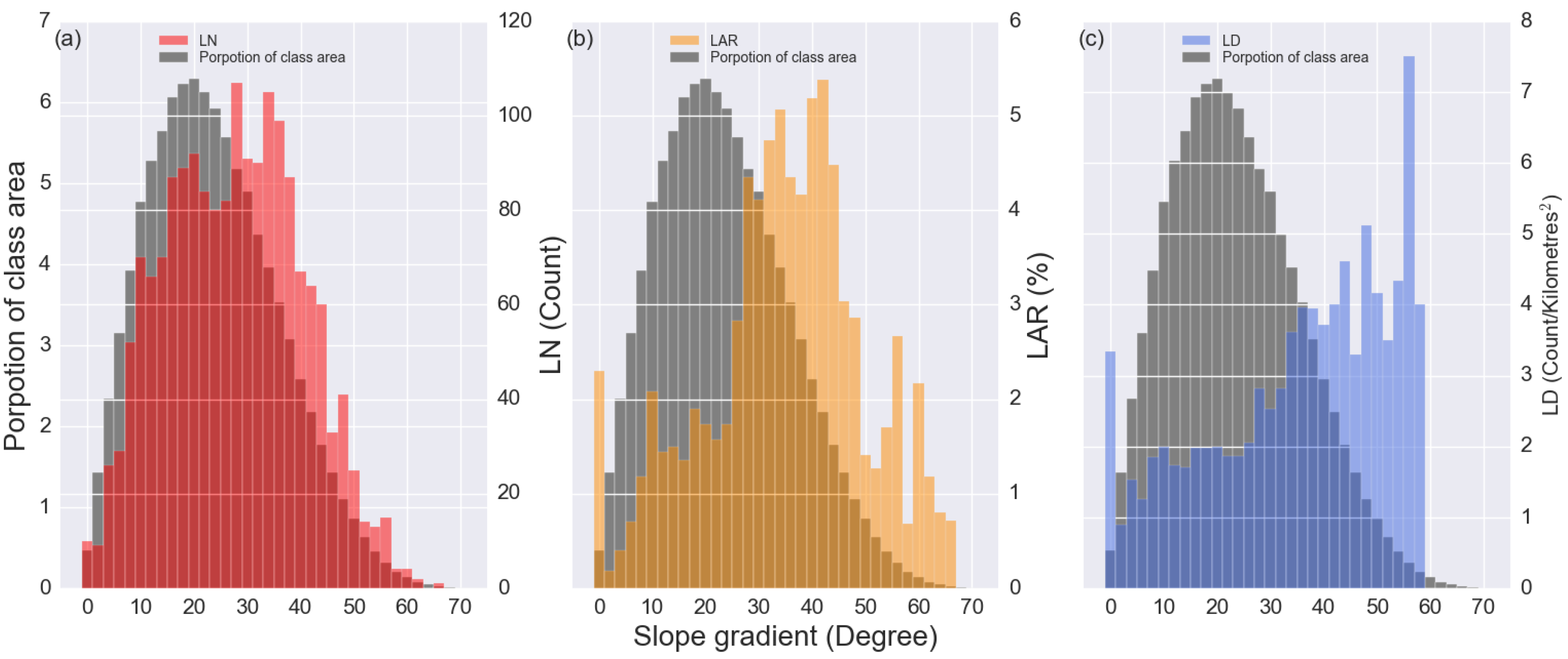
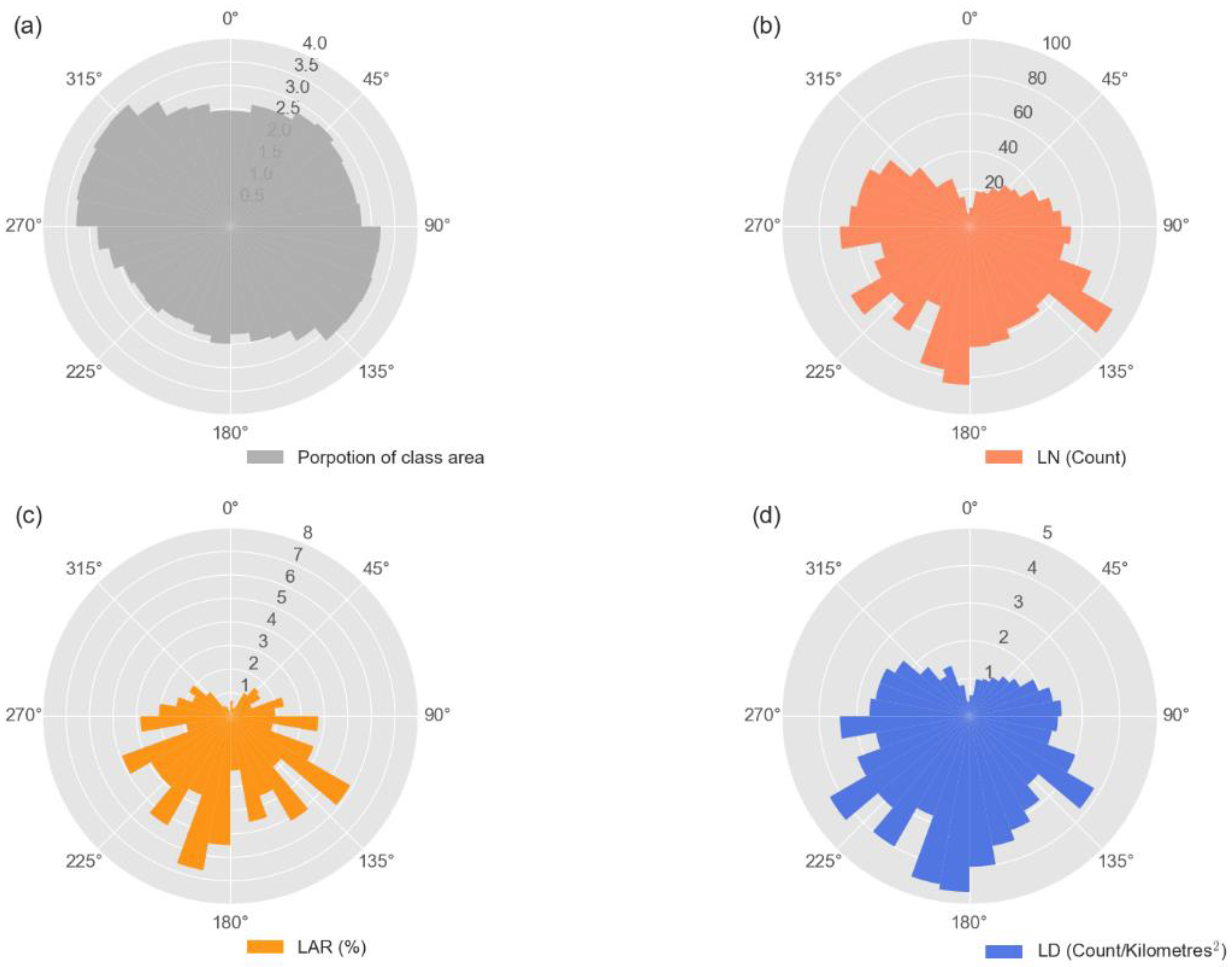
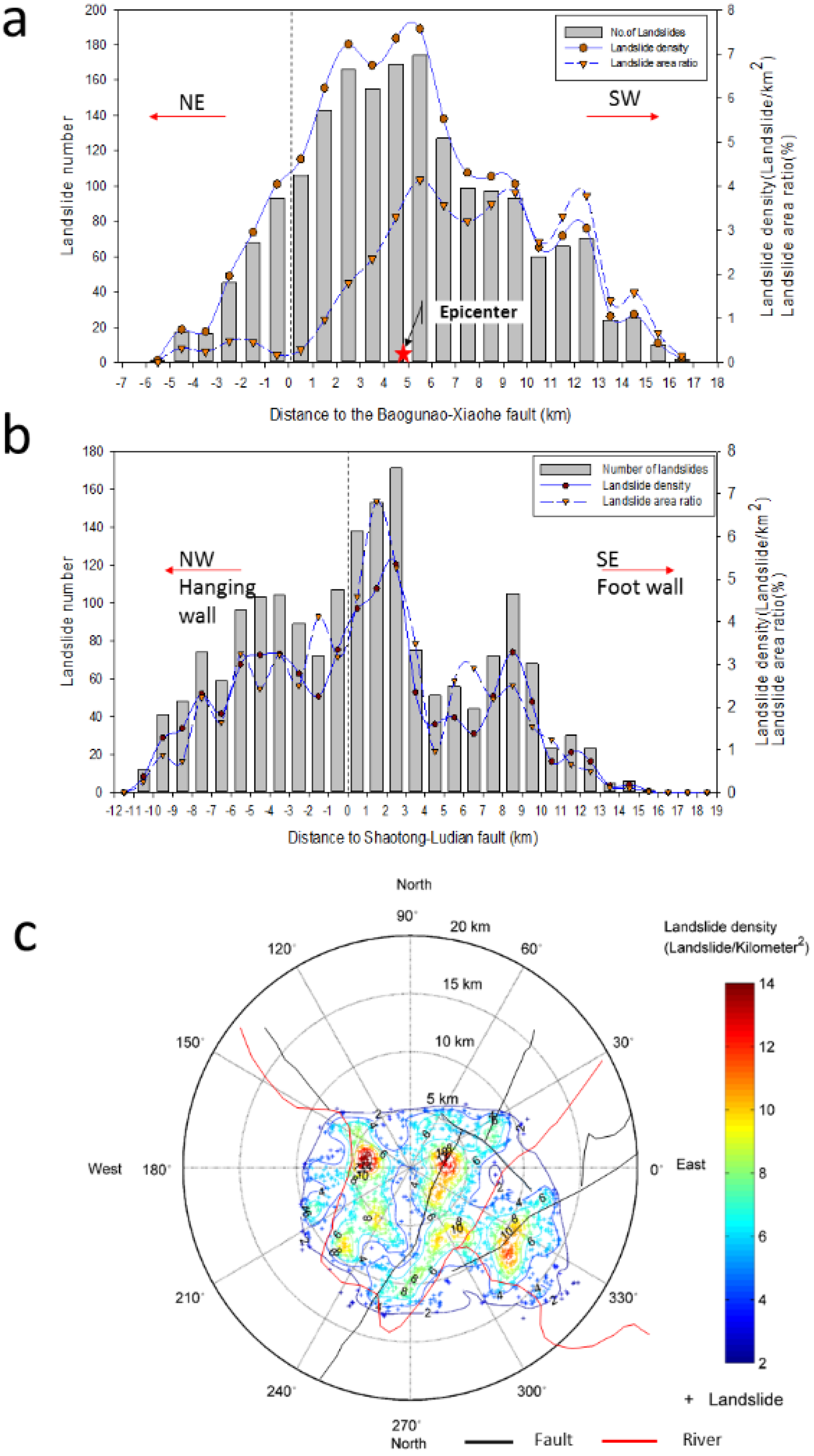
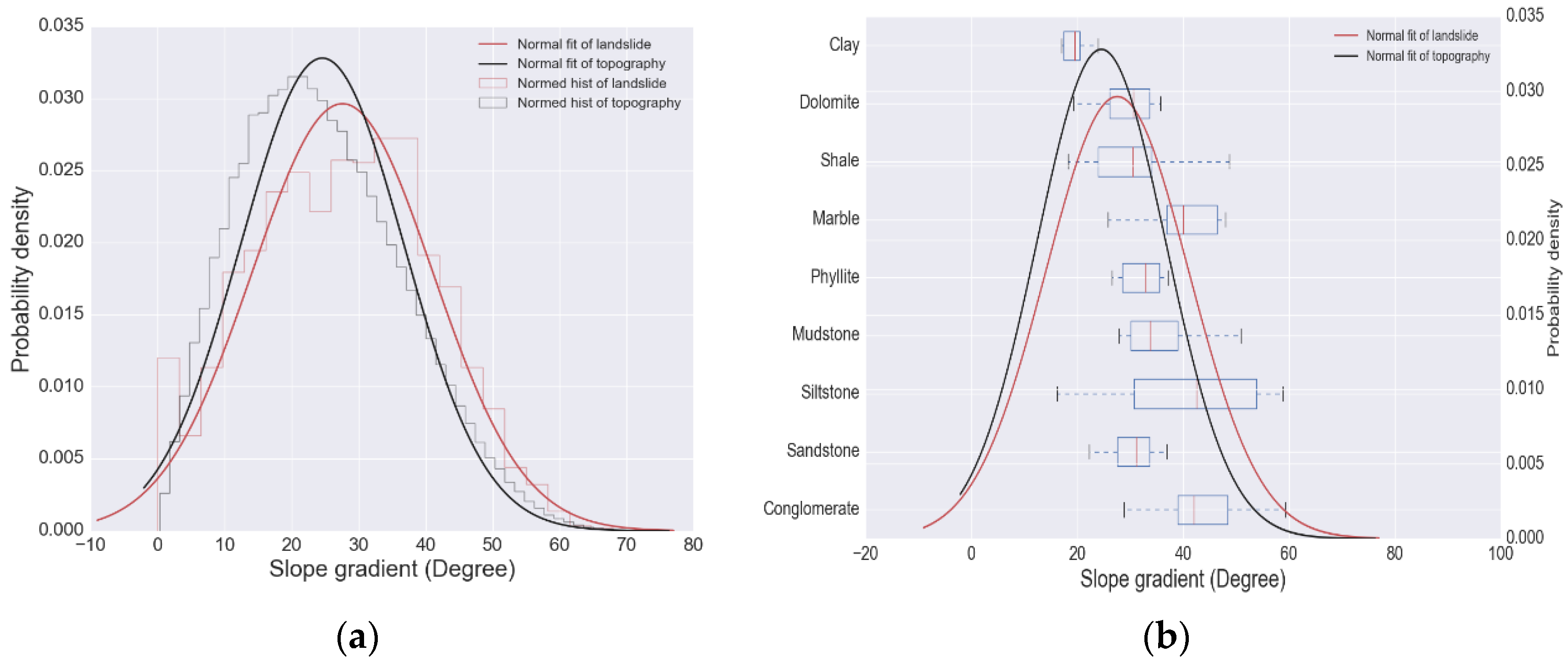
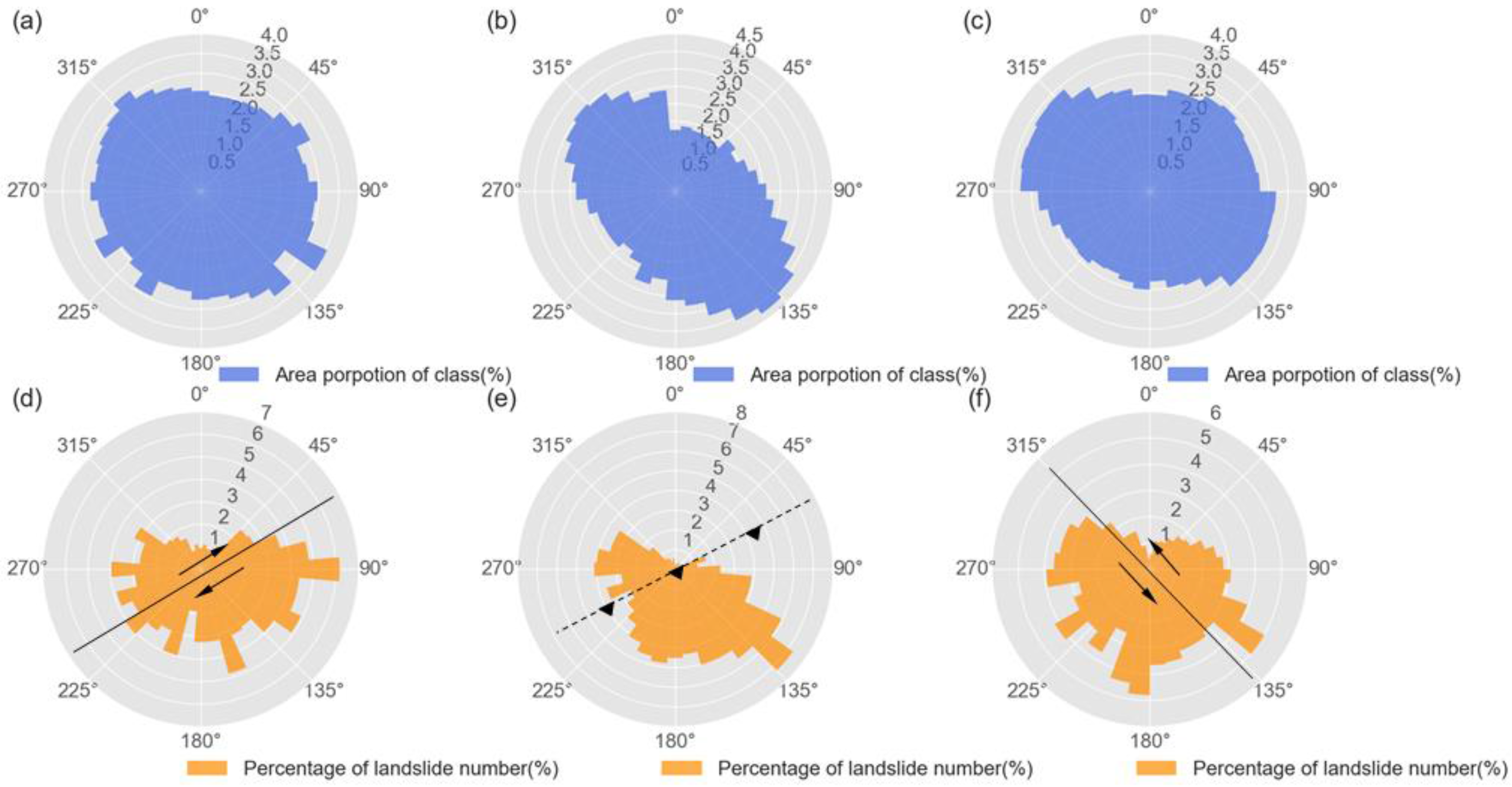
| Date | Location | Ms | Depth (km) | E.I. | L.I. a | M.A (km2) |
|---|---|---|---|---|---|---|
| 5 January 1970 | Tonghai, Yunnan | 7.8 | 13 | X | VII | |
| 5 February 1973 | Luhuo, Sichuan | 7.6 | 11 | X | VIII | 1200 |
| 11 May 1974 | Zhaotong, Yunnan | 7.1 | 14 | IX | VII | 900 |
| 16 August 1976 | Songpan, Sichuan | 7.2 | 15 | IX | VII | |
| 23 August 1976 | Songpan, Sichuan | 7.2 | 23 | VIII | VII | |
| 29 May 1976 | Longling, Sichuan | 7.3 | 24 | IX | VI | 1500 |
| 29 May 1975 | Longling, Sichuan | 7.4 | 21 | IX | VI | |
| 7 November 1976 | Yanyuan, Sichuan | 6.7 | 15 | IX | VII | 400 |
| 24 January 1981 | Daofu, Sichuan | 6.9 | 12 | VIII | VII | 450 |
| 16 November 1988 | Lancang, Yunnan | 7.6 | 13 | X | VII | 1500 |
| 16 November 1988 | Gengma, Yunnan | 7.2 | 8 | X | VIII | 1800 |
| 12 May 2008 | Wenchuan, Sichuan | 8.0 | 33 | XI | VII | 21,000 |
| 7 September 2012 | Yiliang, Yunnan | 5.7 | 14 | VIII | VII | 792 |
| 20 April 2013 | Lushan, Sichuan | 7.0 | 13 | IX | VII |
| Symbols | Stratum | Lithology Description |
|---|---|---|
| C | Carboniferous rocks | Lower part: sandstone, shale with charcoal shale; Upper part: dolomite |
| DC | Devonian-Carboniferous rocks | Sandstone and slate |
| D↓2 | Lower-middle Devonian rocks | Sandstone, siltstone with mudstone and limestone |
| D↓3 | Upper Devonian | Dolomite |
| Nh | Neoproterozoic rocks | Sandstone, limestone with glutenite |
| O | Ordovician rocks | Lower part: shale and sandstone; Upper part: dolomite and limestone |
| OS | Ordovician-Silurian rocks | Shale, siltstone, dolomitic limestone with sandstone and dolomite |
| P↓2 | Middle Permian rocks | Limestone |
| P↓2-3 | Middle-upper Permian rocks | Sandstone with shale, coal bed, limestone and basalt |
| T↓1-2-MA | Lower-middle Triassic rocks | Lower part: conglomerate, sandstone and limestone; Upper part: dolomite with breccia |
| Z↓2 | Upper simian rocks | Dolomite and algal dolomite |
| Є | Cambrian rocks | Shale, sandstone, limestone and dolomite |
| ЄO | Cambrian-Ordovician rocks | Lower part: shale, sandstone, limestone and dolomite; Upper part: shale, sandstone and dolomitic limestone |
| Date | Time | Longitude | Latitude | Depth (km) | Magnitude (Ms) |
|---|---|---|---|---|---|
| 3 August 2014 | 16:30:12.0 | 103.33°E | 27.11°N | 10.0 | 6.6 |
| 3 August 2014 | 19:07:21.2 | 103.37°E | 27.08°N | 21.0 | 4.1 |
| 3 August 2014 | 21:47:10.2 | 103.39°E | 27.10°N | 10.0 | 4.1 |
| 3 August 2014 | 22:28:30.5 | 103.34°E | 27.11°N | 8.0 | 4.2 |
| 4 August 2014 | 03:30:31.6 | 103.36°E | 27.09°N | 5.0 | 4.4 |
| 10 August 2014 | 12:39:12.1 | 103.39°E | 27.05°N | 10.0 | 4.0 |
| Topography | Mean | Variance | 95% Confidence Range | |
|---|---|---|---|---|
| Mean | Variance | |||
| Topography | 24.37° | 13.46° | (23.95°, 24.62°) | (13.10°, 13.88°) |
| Landslide | 27.58° | 12.16° | (27.22°, 28.10°) | (11.49°, 12.37°) |
| Event | Magnitude (Ms) | Seismogenic Fault | Reference |
|---|---|---|---|
| 2008 Wenchuan | 8.0 | Thrust (Strike-slip in north part) | |
| 2013 Lushan | 7.0 | Blind thrust | [26] |
| 2014 Ludian | 6.5 | Strike-slip | CEA # |
© 2016 by the authors; licensee MDPI, Basel, Switzerland. This article is an open access article distributed under the terms and conditions of the Creative Commons by Attribution (CC-BY) license (http://creativecommons.org/licenses/by/4.0/).
Share and Cite
Zhou, S.; Chen, G.; Fang, L. Distribution Pattern of Landslides Triggered by the 2014 Ludian Earthquake of China: Implications for Regional Threshold Topography and the Seismogenic Fault Identification. ISPRS Int. J. Geo-Inf. 2016, 5, 46. https://doi.org/10.3390/ijgi5040046
Zhou S, Chen G, Fang L. Distribution Pattern of Landslides Triggered by the 2014 Ludian Earthquake of China: Implications for Regional Threshold Topography and the Seismogenic Fault Identification. ISPRS International Journal of Geo-Information. 2016; 5(4):46. https://doi.org/10.3390/ijgi5040046
Chicago/Turabian StyleZhou, Suhua, Guangqi Chen, and Ligang Fang. 2016. "Distribution Pattern of Landslides Triggered by the 2014 Ludian Earthquake of China: Implications for Regional Threshold Topography and the Seismogenic Fault Identification" ISPRS International Journal of Geo-Information 5, no. 4: 46. https://doi.org/10.3390/ijgi5040046





